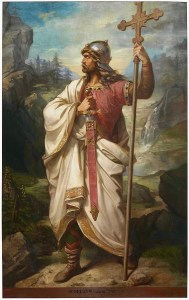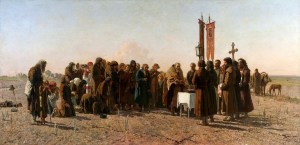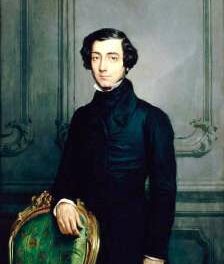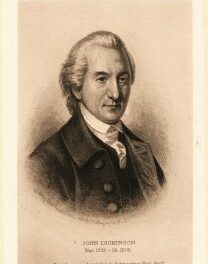We support our Publishers and Content Creators. You can view this story on their website by CLICKING HERE.
Pelagius of Asturias was a warrior of Christendom who is revered by the Catholics of Spain but is largely unknown to the wider world.
 One of the most enchanting places in the whole of Christendom is Covadonga in the Asturias region of northern Spain. The visitor, on approaching it for the first time, could easily imagine that he had stepped through a mystical portal into the elven realm of Lothlórien in Tolkien’s Middle-earth. Looking up through the trees, one sees the towers of the Neo-Romanesque edifice of the Basílica de Santa María la Real de Covadonga looming majestically on the clifftop above, the foliage in the foreground serving as its footstool and the sky beyond as its halo. It’s as though the church had been built in the treetops.
One of the most enchanting places in the whole of Christendom is Covadonga in the Asturias region of northern Spain. The visitor, on approaching it for the first time, could easily imagine that he had stepped through a mystical portal into the elven realm of Lothlórien in Tolkien’s Middle-earth. Looking up through the trees, one sees the towers of the Neo-Romanesque edifice of the Basílica de Santa María la Real de Covadonga looming majestically on the clifftop above, the foliage in the foreground serving as its footstool and the sky beyond as its halo. It’s as though the church had been built in the treetops.
Climbing the hill to the basilica itself, the visitor will see a statue of a knight, sword clasped in his right hand with his left arm held aloft in blessing. This is Pelagius of Asturias (not to be confused with the British heretic of the same name), a warrior of Christendom who is revered by the Catholics of Spain but is largely unknown to the wider world. Such is his importance that it would be no exaggeration to say that Catholic Spain itself would be unknown to the wider world if Pelagius hadn’t made his indelible mark on history.
Pelagius was a young man when the Christian Visigothic kingdom was invaded by Muslim forces from north Africa, beginning the centuries-long occupation of Spain by the power of Islam. The whole of Spain fell to the invaders within a few short years of the initial conquest in A.D. 711. Then, probably in 722, though the actual date is disputed, Pelagius and a small band of followers took a stand at Covadonga. Heavily outnumbered, it must have seemed as if this was to be Christendom’s last stand on Spanish soil.
Pelagius’ rebellion against Arab rule began with his refusal to pay the tax on non-Muslims which had been imposed by the conquerors. He and his small band of followers, many of whom had fled to the mountains of Asturias from other parts of Spain, began to attack the Muslim garrisons in the area and were so successful that they expelled the Arab provincial governor. Pelagius established the Christian kingdom of Asturias and defended it from initial attempts to reimpose Muslim rule. This bastion of Christian resistance was an inspiration which rekindled the courage of the Christians of northern Spain.
At first, the Muslim rulers of Spain largely ignored this inconsequential uprising on the mountainous fringes of the land they’d conquered. They had more ambitious plans, including the invasion of France. It was the defeat of the Islamic army at the Battle of Toulouse, in 721, which set the stage for the Battle of Covadonga. Returning home defeated, the leader of the Muslim army decided that an easy victory against the band of renegades in the mountains of Asturias would help to raise the flagging morale of his men.
Unable to match the sheer size of the advancing Muslim forces, Pelagius and his men withdrew deep into the mountains. Eventually, they decided to take their stand in a narrow valley flanked by high peaks, which would prevent conventional battle lines being formed. Against the might of the Islamic foe, it is thought that Pelagius might have had as few as three hundred men.
The advancing Muslim troops were ambushed by Pelagius’ men, stationed on both sides of them on the mountain slopes, raining down arrows and rocks. Then, at a key moment, Pelagius led his best fighting men out from a cave in which they’d been hiding. In the ensuing battle, the Muslims were roundly defeated and their leader was slain.
News of the victory, against all odds, spread throughout the region. Encouraged by Pelagius’ success, the local Christian population took up weapons and attacked their retreating conquerors. The Muslim forces regrouped but were defeated by Pelagius once again.
The Christian stronghold in the mountains, the Kingdom of Asturias, having been established by Pelagius and defended successfully by him, would never fall into Muslim hands. It was from this stronghold that the Christian reconquest of Spain would begin.
It is unsurprising that a Christian victory, against all the odds, should be accompanied by reports of miraculous divine intervention. According to legend, Pelagius sought refuge in a cave in which a hermit had hidden a statue of the Virgin Mary to save it from desecration at the hands of the Muslim conquerors. Pelagius prayed to the Virgin for victory, and it was through her intercession that the battle was won.
Inspired by Pelagius’ account, King Alfonso I built a monastery and chapel at Covadonga in around A.D. 750, only a few years after Pelagius’ death, in honor of the Virgin. Devotion to Our Lady of Covadonga remains strong to this day with numerous pilgrims still visiting her shrine every year. When they do so, they are also visiting the shrine of Pelagius, who is buried in the holy cave, the site of the miracle. Also buried with him are his wife and King Alfonso I and his wife. This one small cave is, therefore, a shrine to the Queen of Heaven and to two kings and queens of Asturias.
As for Pelagius himself, he might remind us of other warriors of Christendom. We might think of Don John of Austria, who led the Christian fleet against the Muslim armada at the Battle of Lepanto, whose praises were sung so triumphantly by G.K. Chesterton; or Alfred the Great, who sought refuge from an invading army in the wild wastes of his native land and whose praises were sung by Chesterton in The Ballad of the White Horse; or perhaps Robin Hood comes to mind, whose band of merry men fought tyrannical power from their forest fortress. Compared to these highly-lauded and loudly-sung heroes of Christendom, Pelagius is hardly known. It is, therefore, with all due deference to a largely unsung hero that this small song of praise is offered.
Republished with gracious permission from Crisis Magazine (June 2024).
This essay is part of a series, Unsung Heroes of Christendom.
The Imaginative Conservative applies the principle of appreciation to the discussion of culture and politics—we approach dialogue with magnanimity rather than with mere civility. Will you help us remain a refreshing oasis in the increasingly contentious arena of modern discourse? Please consider donating now.
The featured image is “Don Pelayo, rey de Asturias” (between circa 1853 and circa 1856), by Luis de Madrazo, and is in the public domain, courtesy of Wikimedia Commons.
Share This Story, Choose Your Platform!
Go to Top

 Conservative
Conservative  Search
Search Trending
Trending Current News
Current News 






